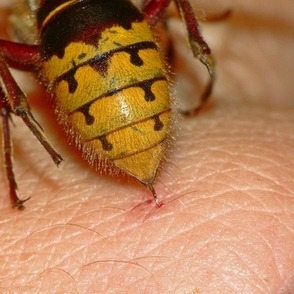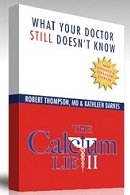|
First Aid for Bee Stings
(Also Wasps and Hornets)
First aid for bee stings - it's not always what you think of including in your first aid kit. But, come summertime, it is a common source of unexpected pain; pain that can be quickly reduced if you are prepared.
After being stung, the first step is to remove the stinger, if the insect is a honeybee (wasps - picture below - and other stinging insects don't leave a stinger behind). A honeybee's stinger, when left in your skin, will still be attached to a venom sac which, if squeezed can inject more venom into you. Rather than grabbing and pulling it off scrape it out with a fingernail, credit card etc. However, getting the stinger out quickly is more important than how you get it out as it will continue injecting on its own.
Then look at these options to help with the pain:
First Aid for Bee Stings - Natural Options and Suggested Treatments:
Items listed here with little information listed may not be very effective. Sometimes however, anything applied with a little sympathy and a "this will help it feel better" can have at least a placebo effect. With a young child, fear is a big part of the experience and if a parent seems calm, reassuring and in control much of the fear will be removed.
- Aluminum-based deodorant dabbed on the wound
- Amylase enzymes can be very helpful to reduce the reaction to a sting.
- Aspirin A randomized trial of aspirin paste showed it was not effective in reducing the duration of swelling or pain and actually significantly increased the duration of redness. (Balit C, Isbister G, Buckley N (2003). "Randomized controlled trial of topical aspirin in the treatment of bee and wasp stings". J. Toxicol. Clin. Toxicol. 41 (6): 801?8.)
- Baking soda (sodium bicarbonate) mixed with enough water to make a paste can be applied and left on the skin for 15 to 20 minutes. The venom is acid.
- Basil leaves, crushed fresh and applied to the sting site.
- Calendula flowers can be rubbed on the sting site.
- Charcoal can be made into a paste with water and applied on the sting site. It can draw toxins out through the skin. Charcoal is a wonderful antidote for a great variety of toxins. It is more effective if mixed with ground flax seed and water to make a thick paste as the flax will keep it from drying out so fast. Drying out (which reduces the effectiveness) can also be delayed by covering the poultice with a layer of plastic wrap. That will also protect from the charcoal, which is very black and messy, getting everywhere.
- Chewing tobacco, a damp paste
- Clay can be made into a poultice like charcoal
- Copper penny. Some claim that the copper in a penny will quickly reduce the pain. There are medical studies relating the successful use of skin creams containing "copper peptide complexes" (a combination of copper and amino acids) to accelerate wound healing but its use for stings has not been clinically tested. Note that U.S pennies minted after 1981 only contain 2.5 percent copper. The rest is zinc.
- Dill pickles
- Epsom salt and water made into a paste
- Garlic a fresh slice applied to the wound can help. It also works internally, so eat some as well.
- Honey
- Ice can help to reduce pain and swelling
- Meat tenderizer contains an enzyme (papain) that breaks down the toxins in insect venom.
- Onion, same as garlic
- Papaya, a fresh slice applied to the wound.
- Parsley leaves, crushed fresh and applied to the sting.
- Plantain leaves can be crushed or chewed up a little and applied directly to the site.
- Salt
- Tea bags
- Toothpaste
- Vinegar
Before First Aid for Bee Stings
- Learn to Avoid the Stings
- Give them space.
- Don't harass bee or wasp nests or try to approach a hive
- Clothing in bright colors makes the insects more aggressive. Beekeepers wear plain white bee suits.
- Perfume or after-shave might attract stinging insects.
- Sources of sugar such as soft drinks (which you shouldn't be drinking anyway) jams, and fruits can attract them. Avoid drinking from a can that a wasp could enter. You don't want to get stung in the mouth!
- If you are making a lot of noise such as when operating a weed eater or lawnmower be aware that you will not hear the buzzing that often comes before the stinging - keep an eye out or scout out the area carefully before you start work.
- If several people are hiking along a trail in a line it is often not the first person that gets stung. After disturbing a nest, such as walking over a yellow jacket nest in the ground it may take several seconds for the critters to start their attack.
- Wasps tend to build their nests on an eastern or southern exposure.
- Watch for queens flying around looking for nesting sites near your home in the spring. It is much easier to deal with a single wasp earlier than a whole nest full later in the season.
Reactions to Stings
Local, nonallergic reactions may include burning pain, itching, redness and swelling. The swelling and itching may last up to a week.
Complications
- Allergies - People who are allergic to bee and wasp stings may suffer a dangerous anaphylactic reaction that is potentially deadly.
- Anaphylactic shock can be life-threatening. It can come on very quickly after a sting or may be delayed for hours. Signs of anaphylaxis include:
- itching
- redness
- hives (raised welts)
- shortness of breath
- People who are allergic will often carry an EpiPen and should use it immediately if stung. It contains epinephrine, a prescription hormone that supports blood pressure, increases heart rate, and relaxes airways. Antihistamines, such as Benedryl (diphenhydramine), can slow down an anaphylactic reaction, but will not stop it - seek medical attention quickly.
- Multiple stings - anyone stung more than 10 times should seek medical attention.
- Stings inside the nose mouth or throat should receive medical attention in case swelling causes breathing problems.
Other Information
The most aggressive stinging insects are wasps such as bald-faced hornets and yellow jackets. Most honey bees and others if they are just going about their business will leave you alone unless you step on them, inadvertently grab them or seem to be threatening their nest.
Honey bee stings release pheromones that may call other nearby bees to also attack.
Bee venom is acidic and some home remedies are suggested with the idea to neutralize the venom. However, there may be little neutralizing with many topical applications as the venom is injected into the tissues where they are unable to reach.
Insect repellants such as you would use to ward off mosquitoes are not effective against bees and wasps.
Wasp traps can be very effective to reduce the number of wasps in an area.
Fake wasp nests can keep wasps from establishing a new nest in an area as they are territorial.
|
Keep up to date with
valuable insights into
pain management via
a healthy lifestyle.
Receive the monthly
Natural Pain Relief
Guide Newsletter.
News articles, health
tips, specials, freebies.
Enter your email and name
in the form to the right.
|
|
|









New! Comments
Have your say about what you just read! Leave me a comment in the box below.